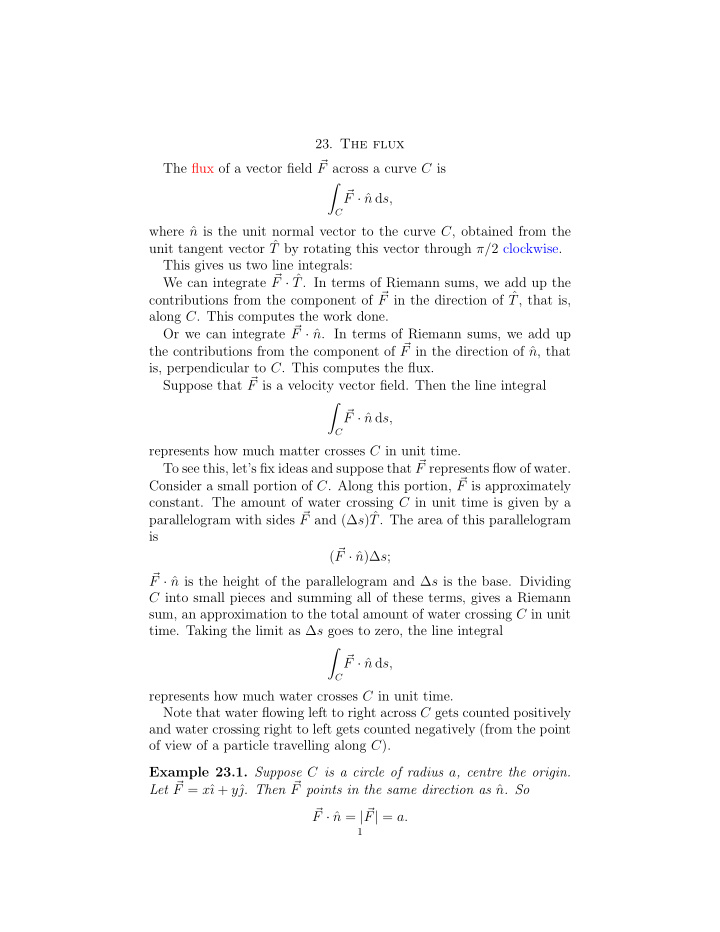



23. The flux The flux of a vector field � F across a curve C is � � F · ˆ n d s, C where ˆ n is the unit normal vector to the curve C , obtained from the unit tangent vector ˆ T by rotating this vector through π/ 2 clockwise. This gives us two line integrals: We can integrate � F · ˆ T . In terms of Riemann sums, we add up the contributions from the component of � F in the direction of ˆ T , that is, along C . This computes the work done. Or we can integrate � F · ˆ n . In terms of Riemann sums, we add up the contributions from the component of � F in the direction of ˆ n , that is, perpendicular to C . This computes the flux. Suppose that � F is a velocity vector field. Then the line integral � � F · ˆ n d s, C represents how much matter crosses C in unit time. To see this, let’s fix ideas and suppose that � F represents flow of water. Consider a small portion of C . Along this portion, � F is approximately constant. The amount of water crossing C in unit time is given by a parallelogram with sides � F and (∆ s ) ˆ T . The area of this parallelogram is ( � F · ˆ n )∆ s ; � F · ˆ n is the height of the parallelogram and ∆ s is the base. Dividing C into small pieces and summing all of these terms, gives a Riemann sum, an approximation to the total amount of water crossing C in unit time. Taking the limit as ∆ s goes to zero, the line integral � � F · ˆ n d s, C represents how much water crosses C in unit time. Note that water flowing left to right across C gets counted positively and water crossing right to left gets counted negatively (from the point of view of a particle travelling along C ). Example 23.1. Suppose C is a circle of radius a , centre the origin. Let � . Then � F = x ˆ ı + y ˆ F points in the same direction as ˆ n . So � n = | � F · ˆ F | = a. 1
It follows that � � � a d s = 2 πa 2 . F · ˆ n d s = C C The flux is 2 πa 2 . On the other hand, suppose we start with � F = − y ˆ ı + x ˆ . Then � F · ˆ n = 0 , since � F is perpendicular to ˆ n . The flux is zero. Note that this makes sense physically. In the first example, water is spewing out of the origin. Lots of it crosses C . In the second example, water is spinning around the origin. None of it crosses C . Now let’s turn to how we would calculate the flux algebraically. We have r = ˆ d � T d s = � d x, d y � . n is obtained from ˆ The vector ˆ T by rotation through π/ 2 clockwise. So ˆ n d s = � d y, − d x � . So as not to get lost in notation, let’s suppose the components of � F are P and Q , � F = � P, Q � = P ˆ ı + Q ˆ . We have � � � � F · ˆ n d s = � P, Q � · � d y, − d x � = − Q d x + P d y. C C C Theorem 23.2 (Green’s Theorem for flux) . If C is a positively oriented closed curve enclosing a region R and � F = P ˆ ı + Q ˆ then � �� div � div � − Q d x + P d y = F d A, where F = P x + Q y . C R 2
Proof. Call M = − Q and N = P , so that � G = � M, N � is � F rotated through π/ 2 anticlockwise. Then we have � � − Q d x + P d y = M d x + N d y C C �� curl � = G d y R �� = N x − M y d y R �� = P x + Q y d y R �� div � = F d A. � R Example 23.3. Consider the example of a circle C of radius a , centre the origin. Suppose that � F = x ˆ ı + y ˆ . Then div � F = 1 + 1 = 2 . So the RHS of (23.2) is �� 2 d A = 2 πa 2 . R Suppose we move the circle away from the origin. Then computing the LHS becomes quite hard. But the RHS is unchanged. div � F is called the divergence of � F . If � F is the velocity vector field of water, the divergence measures how much water is being added (or taken away); these are known as sources (or sinks). For the vector field � F = x ˆ ı + y ˆ , water is being added everywhere (imagine rain falling on the ground and then flowing away from the origin). For the vector field � F = − y ˆ ı + x ˆ the divergence is zero. No water is being added or removed, there are no sources or sinks. 3
Recommend
More recommend